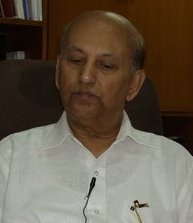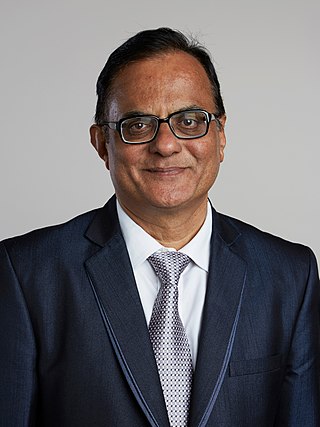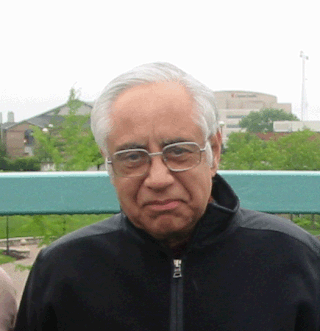
Ashoke Sen FRS is an Indian theoretical physicist and distinguished professor at the International Centre for Theoretical Sciences (ICTS), Bengaluru. He is also an honorary fellow in National Institute of Science Education and Research (NISER), Bhubaneswar, India and also a Morningstar Visiting professor at MIT and a distinguished professor at the Korea Institute for Advanced Study. His main area of work is string theory. He was among the first recipients of the Fundamental Physics Prize "for opening the path to the realization that all string theories are different limits of the same underlying theory".

Udupi Ramachandra Rao was an Indian space scientist and former chairman of the Indian Space Research Organisation. He was also the Chairman of the Governing Council of the Physical Research Laboratory at Ahmedabad and Nehru Planetarium at Bengaluru and chancellor of the Indian Institute for Space Science and Technology (IIST) at Thiruvananthapuram. He is known as "The Satellite Man of India". He pioneered India's first satellite launch Aryabhata in 1975.
M. R. N. Murthy, was a professor of molecular biophysics at the Indian Institute of Science, IISc, Bangalore. He currently teaches at the Institute of Bioinformatics and Applied Biotechnology, Bengaluru. His chief contributions are in the area of X-ray crystallography. He was awarded the Shanti Swarup Bhatnagar award for outstanding contribution to physical sciences, which is the highest honour for a scientist in India, in the year 1992.

Debashis Mukherjee is a theoretical chemist, well known for his research in the fields of molecular many body theory, theoretical spectroscopy, finite temperature non-perturbative many body theories. Mukherjee has been the first to develop and implement a class of many-body methods for electronic structure which are now standard works in the field. These methods, collectively called multireference coupled cluster formalisms, are versatile and powerful methods for predicting with quantitative accuracy the energetics and cross-sections of a vast range of molecular excitations and ionization. A long-standing problem of guaranteeing proper scaling of energy for many electron wave-functions of arbitrary complexity has also been first resolved by him. He has also been the first to develop a rigorously size-extensive state-specific multi-reference coupled cluster formalism, and its perturbative counterpart which is getting increasingly recognized as a very promising methodological advance.
Ayyagari Sambasiva Rao (1914–2003) was an Indian scientist and founder of Electronics Corporation of India Limited (ECIL), Hyderabad, Telangana, India.

Prof. Kotcherlakota Rangadhama Rao was an Indian physicist in the field of Spectroscopy.

Patcha Ramachandra Rao was a metallurgist and administrator. He has the unique distinction of being the only Vice-Chancellor (2002–05) of the Banaras Hindu University (BHU) who was also a student (1963–68) and faculty (1964–92) at that institution. From 1992 to 2002, Rao was the Director of the National Metallurgical Laboratory, Jamshedpur. After his tenure as Vice-Chancellor of B.H.U., in 2005, he took the reins of the Defence Institute of Advanced Technology (DIAT) as its first Vice-Chancellor. He was to serve DIAT until his superannuation in 2007. From 2007 till the end, Rao was a Raja Ramanna Fellow at the International Advanced Research Centre for Powder Metallurgy and New Materials, in Hyderabad, Andhra Pradesh.
Nishtala Appala Narasimham, shortly N. A. Narasimham was an Indian physicist and spectroscopist.
Palle Rama Rao FREng is an Indian scientist noted for his contribution to the field of Physical and Mechanical Metallurgy. He has collaborated and conducted research activities for over dozen universities and associations all over India and abroad. He has been honoured with the titles of Padma Vibhushan in 2011 by president of India for his contributions to scientific community. He is acting as the chairman, Governing Council, International Advanced Research Centre for Powder Metallurgy & New Materials (ARCI), Hyderabad.

Ajay Kumar Sood is an Indian physicist, researcher and is serving as the 4th Principal Scientific Adviser to the Government of India. He is also holder of 2 US and 5 Indian patents, known for his pioneering research findings on graphene and nanotechnology. He is a Distinguished Honorary Professor of Physics at Indian Institute of Science, Bangalore. The Government of India honoured him in 2013, with the Padma Shri, the fourth highest civilian award, for his contributions to the fields of science and technology. Sood was elected a Fellow of the Royal Society (FRS) in 2015. He has been on the Physical Sciences jury for the Infosys Prize from 2019.
Dipankar Das Sarma, popularly known as D.D. Sarma, is an Indian scientist and structural chemist, known for his researches in the fields of Solid State Chemistry, Spectroscopy, Condensed Matter Physics, Materials Science, and Nanoscience. He is a former MLS Chair Professor of Physics and Chairman of the Centre for Advanced Materials and the GAST Professor of Uppsala University, Sweden, A recipient of TWAS Physics Prize and the UNESCO Biennial Javed Husain Prize, Sarma was honored by the Council for Scientific and Industrial Research (CSIR), Government of India, in 1994, with the Shanti Swarup Bhatnagar Prize for Science and Technology.

Alla Venkata Rama Rao is an Indian inventor and chemist, known for his pioneering researches in the field of drug technology. He is the founder of the A. V. Rama Rao Research Foundation, a non governmental organization promoting research and doctoral studies in chemistry and Avra Laboratories, an organization dealing in intermediates and active pharmaceutical ingredients, used in therapeutics. An elected fellow of the Indian National Science Academy, Indian Academy of Sciences, National Academy of Sciences, India, and Third World Academy of Sciences (TWAS), Rama Rao is a recipient of several awards such as TWAS Technology Award, VASVIK Industrial Research Award and Om Prakash Bhasin Award. The Government of India awarded him Padma Shri in 1991 and Padma Bhushan in 2016.
Vishnu Ganesh Bhide (1925–2006) was an Indian physicist and educationist, known for his pioneering work on Mossbauer spectroscopy and his contributions to science education in India. He was the scientific advisor to the Government of India during 1973-75 and a member of the International Commission on the Applications of Mossbauer Effect. The Government of India awarded him the fourth highest civilian honour of the Padma Shri in 1992.

Kasturi Lal Chopra was an Indian materials physicist and a former director of the Indian Institute of Technology, Kharagpur. He was the founder of the Thin Film Laboratory at Indian Institute of Technology, Delhi and the Microscience Laboratory at IIT, Kharagpur and held several US and Indian patents for his research findings. Author of a number of books on thin film technology, he was a recipient of Shanti Swarup Bhatnagar Prize, the highest Indian award in the science and technology categories. The Government of India awarded him the fourth highest civilian honour of the Padma Shri, in 2008, for his contributions to science and engineering.
Mihir Chowdhury FNA, FASc was an Indian physical chemist and Professor and Head of Department of Chemistry at Presidency College, Kolkata and at the Department of Physical Chemistry of the Indian Association for the Cultivation of Science (IACS). He is known for his studies on the electronic structure of molecules using optical, magneto-optical and quantum-mechanical methods. He was an elected fellow of the Indian National Science Academy and the Indian Academy of Sciences. The Council of Scientific and Industrial Research, the apex agency of the Government of India for scientific research, awarded him the Shanti Swarup Bhatnagar Prize for Science and Technology, one of the highest Indian science awards, in 1977, for his contributions to chemical sciences. Three of his research students were also Shanti Swarup Bhatnager awardees.
Chunni Lal Khetrapal was an Indian chemical physicist and a vice chancellor of Allahabad University. He was known for his studies in chemical physics, particularly in the field of Nuclear magnetic resonance spectroscopy. He was an elected fellow of the Indian National Science Academy and the National Academy of Sciences, India. The Council of Scientific and Industrial Research, the apex agency of the Government of India for scientific research, awarded him the Shanti Swarup Bhatnagar Prize for Science and Technology, one of the highest Indian science awards, in 1982, for his contributions to chemical sciences.
Siva Umapathy is the current Director of the Indian Institute of Science Education and Research (IISER) Bhopal. He is an Indian laser spectroscopist and was the Chair of the Department of Inorganic and Physical Chemistry and a Professor of Instrumentation and Applied Physics at the Indian Institute of Science. He is known for his studies of molecular dynamics using Raman spectroscopy and is a fellow of the Royal Society of Chemistry and an elected fellow of the Indian Academy of Sciences and also The National Academy of Science of India, The Council of Scientific and Industrial Research, the apex agency of the Government of India for scientific research, awarded him the Shanti Swarup Bhatnagar Prize for Science and Technology, one of the highest Indian science awards, in 2004, for his contributions to chemical sciences.

Chanchal Kumar Majumdar was an Indian condensed matter physicist and the founder director of S.N. Bose National Centre for Basic Sciences. Known for his research in quantum mechanics, Majumdar was an elected fellow of all the three major Indian science academies – the Indian National Science Academy, the National Academy of Sciences, India, and the Indian Academy of Sciences – as well a member of the New York Academy of Sciences and the American Physical Society.
Nivrathi Suryanarayanashastry Satya Murthy was an Indian physicist and the head of the Nuclear Physics Division of Bhabha Atomic Research Centre. Known for his research in Molecular reaction dynamics, Murthy was an elected fellow of the Indian National Science Academy, National Academy of Sciences, India and Indian Academy of Sciences. The Council of Scientific and Industrial Research, the apex agency of the Government of India for scientific research, awarded him the Shanti Swarup Bhatnagar Prize for Science and Technology, one of the highest Indian science awards, for his contributions to Physical Sciences in 1980.

Anil Kumar is an Indian experimental physicist known for his work in the field of nuclear magnetic resonance spectroscopy. He is a professor at the Indian Institute of Science in Bangalore.









